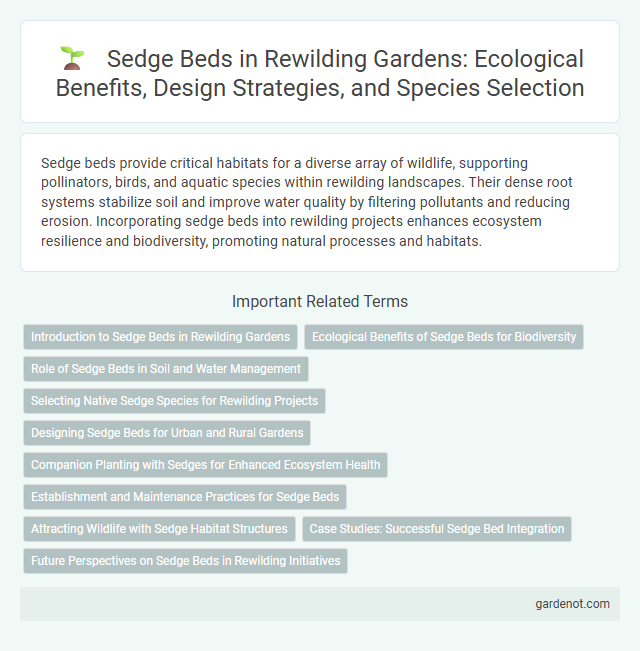Sedge beds provide critical habitats for a diverse array of wildlife, supporting pollinators, birds, and aquatic species within rewilding landscapes. Their dense root systems stabilize soil and improve water quality by filtering pollutants and reducing erosion. Incorporating sedge beds into rewilding projects enhances ecosystem resilience and biodiversity, promoting natural processes and habitats.
Introduction to Sedge Beds in Rewilding Gardens
Sedge beds in rewilding gardens serve as vital habitats for diverse wildlife, including pollinators and amphibians, enhancing ecosystem resilience. These dense clusters of clump-forming sedges improve soil stabilization and water filtration, contributing to a balanced wetland environment. Incorporating sedge beds increases biodiversity while supporting natural ecological processes essential in rewilding efforts.
Ecological Benefits of Sedge Beds for Biodiversity
Sedge beds create essential habitats that support diverse wildlife by providing shelter and breeding grounds for numerous bird, insect, and amphibian species. Their dense root systems stabilize soil and improve water quality by filtering pollutants, promoting healthier aquatic ecosystems. These wetland habitats enhance biodiversity by fostering complex food webs and increasing species richness within rewilded landscapes.
Role of Sedge Beds in Soil and Water Management
Sedge beds play a critical role in soil stabilization and water filtration, reducing erosion by anchoring soil with their dense root systems. These wetlands improve water quality by trapping sediments and absorbing excess nutrients, preventing runoff into adjacent ecosystems. Their natural water retention capacity helps regulate hydrological cycles, mitigating flood risks and maintaining groundwater recharge.
Selecting Native Sedge Species for Rewilding Projects
Selecting native sedge species for rewilding projects enhances biodiversity by restoring natural habitats and supporting local wildlife. Native sedges like Carex stricta and Carex vulpinoidea thrive in wetland areas, improving soil stability and water filtration. Prioritizing region-specific sedge species ensures ecological balance and promotes resilient ecosystems.
Designing Sedge Beds for Urban and Rural Gardens
Designing sedge beds for urban and rural gardens enhances biodiversity, improves water filtration, and requires selecting native Carex species adapted to local soil and moisture conditions. Incorporate varying heights and textures to create layered habitats that support pollinators and wildlife while reducing maintenance needs. Strategic placement near water features or shaded areas optimizes growth and ecological benefits in both urban landscapes and rural settings.
Companion Planting with Sedges for Enhanced Ecosystem Health
Sedge beds support companion planting by fostering diverse plant species that improve soil health and water filtration, enhancing ecosystem stability. Integrating sedges with native wildflowers and grasses creates habitats for pollinators, birds, and beneficial insects, promoting biodiversity. This synergistic planting strategy helps control erosion, boosts nutrient cycling, and supports rewilding goals for resilient, self-sustaining ecosystems.
Establishment and Maintenance Practices for Sedge Beds
Establishment of sedge beds involves selecting native sedge species suited to local hydrology, followed by soil preparation that mimics natural wetland conditions to promote root anchorage and nutrient uptake. Maintenance practices include controlling invasive species through manual removal or targeted herbicides, along with periodic water level management to sustain the saturated environment essential for sedge growth. Regular monitoring of plant health and sediment deposition supports long-term ecological function and habitat stability in rewilding projects.
Attracting Wildlife with Sedge Habitat Structures
Sedge beds create essential habitats that attract diverse wildlife, including amphibians, birds, and beneficial insects by offering shelter and breeding grounds. The dense, fibrous structure of sedge plants stabilizes soil and retains moisture, supporting aquatic and semi-aquatic species vital for ecosystem balance. Incorporating native sedge species in wetland restoration enhances biodiversity and fosters natural food webs critical for sustainable rewilding projects.
Case Studies: Successful Sedge Bed Integration
Sedge beds have demonstrated exceptional success in wetland restoration projects, notably in the Norfolk Broads where they enhanced biodiversity and improved water quality. Research from the Wicken Fen Reserve revealed that sedge bed integration increases habitat complexity, supporting diverse bird and amphibian populations. These case studies highlight sedge beds as vital components for rewilding efforts, promoting ecosystem resilience and natural hydrological cycles.
Future Perspectives on Sedge Beds in Rewilding Initiatives
Future perspectives on sedge beds in rewilding initiatives emphasize their role in enhancing biodiversity and restoring wetland ecosystems. Sedge beds contribute to carbon sequestration, water filtration, and provide critical habitat for wildlife, supporting ecosystem resilience. Advances in ecological monitoring and habitat management enable optimized restoration efforts, promoting long-term sustainability of sedge-dominated wetlands.
Sedge bed Infographic

 gardenot.com
gardenot.com